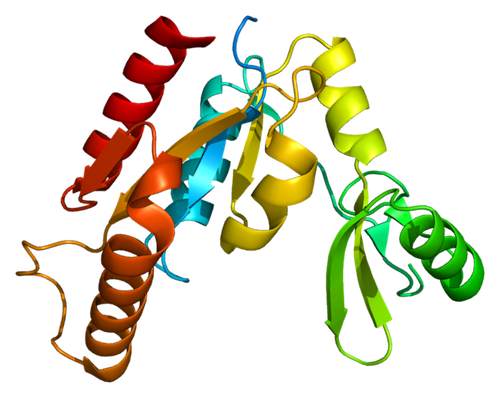 Evolution
Evolution
 Intelligent Design
Intelligent Design
First, Pseudogenes Found to Have Function; Now Pseudoenzymes

A new study casts serious doubt on what scientists consider useless in the cell. “Dead” enzymes thought to be evolutionary relics now show a regulatory function, as Science Magazine tells the story. In “Dead or Alive,” Mitch Leslie writes,
The enzymatic competence of proteins can be difficult to judge, and some apparent pseudoenzymes have fooled researchers. (Emphasis added.)
Case in point: CASK is a “classic pseudokinase,” lacking the ability to do what kinases normally do. That is, swipe a phosphate group from ATP and pass it to another protein. New evidence shows that CASK “serves as a catalyst, albeit a weak one.” Its role in the cell remains unclear, “leaving its pseudostatus up in the air.”
Mitch Leslie’s longer article in Science, “‘Dead’ Enzymes Show Signs of Life,” shows that the CASK story is the tip of an iceberg threatening the ship of knowledge of cell functions.
It didn’t make sense to think the body would invest energy in producing useless proteins:
Biologists were taken aback about a decade ago when they began to realize that a large fraction of human enzymes appear to be duds. That realization was a shock because we can’t live without the enzymes that promote biochemical reactions. So how could so many of these critical molecules have lost their key function? And why does the body keep on producing apparently inert proteins?
Some thought they must have got it wrong. Turns out, they were right to think it was wrong, Leslie says. For one thing, pseudoenzymes are found in all kingdoms of life. For another, they are highly conserved: evolution has not modified them. This suggests they are there for a purpose:
Sure enough, many supposedly inactive enzymes are gainfully employed in organisms — not as catalysts, but in a variety of other roles, researchers are now finding. Some help “true” enzymes catalyze biochemical reactions by forcing them into the correct shape. Others provide platforms where proteins can mingle. Still others join with receptors to help cells communicate, serve as bodyguards that escort proteins to new locations, or perform other tasks. “They turn out to be biologically really important,” says protein chemist Susan Taylor of the University of California, San Diego. “They have been conserved for a reason.“
Researchers are beginning to take a second look at “forgotten genes” that code for pseudoenzymes. Evolutionists believe they will provide insight into “enzyme evolution.” Drug designers “hope to exploit them to create safer, more specific medications.” Other scientists just want to know what they’re there for.
And pseudoenzymes are causing biochemists to rethink some of their ideas about how conventional enzymes work. “If I were starting out again, I’d work on these [pseudoenzymes],” says biochemist Dario Alessi, also of the University of Dundee.
Always ready to speculate, Darwinian evolutionists imagine ways they came to be. Maybe there was a gene duplication event, after which one of the copies mutated to produce the pseudogene for a pseudoenzyme. On the other hand, maybe it was the other way around: the pseudogene was the ancestor of the active gene. Leslie does not provide evidence for either “scenario” other than to state, “A few dead enzymes do seem to have been the ancestors of living ones: Their functional descendants are recognizable because other members of the immediate family are not enzymes.” Such evidence begs the question; it could support either scenario, or neither.
Fact is, some pseudoenzymes are found to be functional. Usually they are found in association with related active enzymes, often in the same tissues at the same time. This makes them “perfectly poised to have a regulatory role,” one biochemist opines. For instance, one pseudoenzyme that retains binding ability puts the active enzyme “into its active pose, allowing it to perform its job.” Another allows an enzyme to detach from one organelle so it can reach the cell membrane. Without that helping hand, the active enzyme fails to reach its destination, leaving the subject’s immune response compromised.
Unfortunately, some disease pathogens hijack pseudoenzymes to confound the immune system. Some pathogens are “rife with dead enzymes,” Leslie writes. This potentially gives them more tools to throw at the host’s defenses. The all-out-war scenario in Michael Behe’s The Edge of Evolution comes to mind: not evolutionary progress, but last-ditch efforts to stay alive.
The new findings have larger implications — humbling implications that further dismantle the “junk DNA” myth. Scientists can no longer assume they know the difference between useful and useless parts in the cell. Leslie concludes,
Even if pseudoenzymes haven’t yet made much of a practical impact, they’ve had an intellectual effect, according to Eyers. “Pseudokinases have made us think, ‘We really don’t know so much about kinases,'” he says. As a result, biochemists are taking a second look at basic questions, such as how much activity an enzyme has to show to be considered functional. At a broader level, the discovery of this new category of inactive enzymes reveals how little researchers understand about parts of the genome, Freeman says. “I’m intrigued by the concept that there are a lot of genes that we know nothing about.“
Considering this setback — another in a series of evolutionary errors caused by jumping to conclusions — it would seem a different mindset would help. Try this: If it’s there, it probably has a purpose. That working assumption would have prevented years of wrong leads about vestigial organs, junk DNA, and now pseudoenzymes. Some critics of the theory of intelligent design argue that evolutionary theory leads to fruitful research, while ID does not. Let the record speak for itself. If researchers brought the framework of intelligent design to bear earlier, we might have had medical breakthroughs and greater understanding of the cell years ago. Instead, Darwinian theory has led to another sorry case of backtracking.
